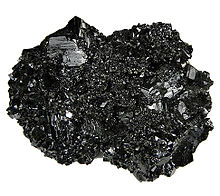Black tin
Appearance

Black tin is the raw ore of tin, usually cassiterite, as sold by a tin mine to a smelting company. After mining, the ore has to be concentrated by a number of processes to reduce the amount of gangue it contains before it can be sold. It contrasts with white tin, which is the refined, metallic tin produced after smelting.
The term "black tin" was historically associated with tin mining in Devon and Cornwall.
References
- Chambers's encyclopædia: A dictionary of universal knowledge. 1868. p. 448.
- Blanchard, Ian (2005). Mining, Metallurgy, and Minting in the Middle Ages: Continuing Afro-European Supremacy, 1250-1450. p. 1526. ISBN 9783515087049.
- Carew, Richard (1811). Carew's Survey of Cornwall: To which are added, notes illustrative of its history and antiquities. p. 40.
- Rickard, William (1859). The miner's manual of arithmetic and surveying ...: With a compendium of mensuration and a concise treatise on practical geometry and plane trigonometry; also a course of mine surveying ... Together with levelling and land surveying. p. 38.
